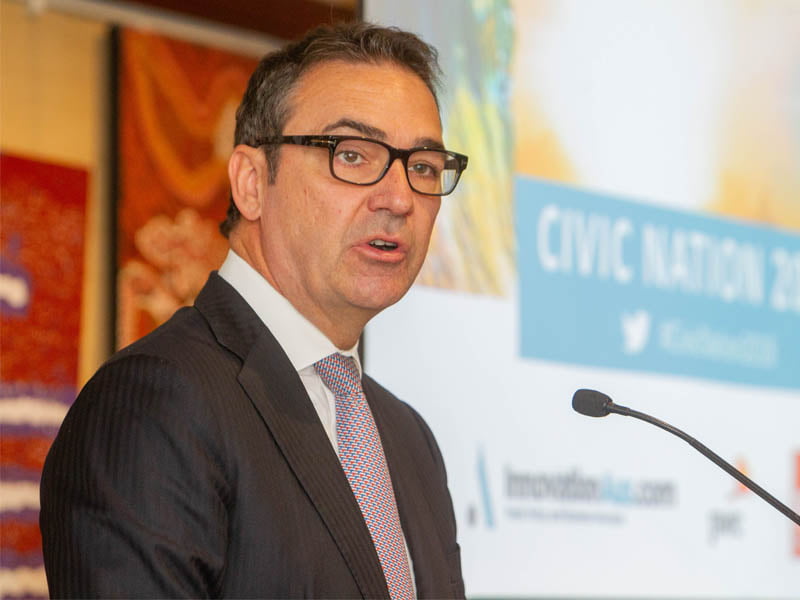South Australian Premier Steven Marshall has a grand plan make his state Australia’s innovation leader within a decade.
The centrepiece of the strategy is the conversion of the old Royal Adelaide Hospital site on North Terrace into an innovation hub, with the romantic and catchy name Lot Fourteen.
“South Australia has a huge opportunity,” said Mr Marshall during his keynote ‘On the Precipice of Disruption’ at InnovationAus.com’s Civic Nation forum in Sydney.

“We have been looking in the rear vision mirror for too long. We will not be putting up apartments on the hospital site. We have seven hectares in the middle of the city where we can create the most exciting innovation precinct in the country.”
The initiative is part of a total revamp of South Australia’s innovation technology strategy. After he was elected in March, Mr Marshall scrapped the state’s startup support agency TechInSA and axed the position of ‘chief innovator’.
It was replaced by a new Office of the Chief Entrepreneur, with an Entrepreneurship Advisory Board established to oversee the $27.5 million Lot Fourteen redevelopment. TechInSA’s campus in suburban Thebarton will be shut down and the activities moved to the new North Terrace development.
The chief entrepreneur role has gone to former fighter RAAF fighter pilot and Harvard graduate Jim Whalley, co-founder and chairman of defence industry firm Nova Systems. It is a part-time role for which Mr Whalley will receive no pay.
“Mr Whalley is very experienced in the tech space. He is very focused and very excited about the future, as am I,” said Mr Marshall. “I am passionate about this. It’s the most exciting time in our history.
“The new innovation hub will be driven by researchers and startups. It will not be curated by the government. Government’s role is to foster a competitive environment and minimise red tape. We have also announced Australia’s first state Productivity Commission.”
Mr Marshall says he is not a traditional politician. He ran the family business Marshall Furniture before selling it to South African-German retail multinational Steinhoff in 2001.
He was prominent in the South Australian business community before entering politics in 2010, when he successfully contested the suburban Adelaide seat of Norwood for the Liberal Party.
He became opposition leader in 2013, losing one election to the ALP before taking government after the 2018 election. In that election, at first dominated by Nick Xenophon’s quixotic bid to enter state politics, the Liberal Party had narrow win despite a small swing against them – Xenophon’s South Australia First disrupted the conventional ALP versus Liberal contest.
Former Labor Premier Jay Weatherill had been a vocal proponent of technology, championing such innovations as autonomous vehicles and promoting the usage of renewable energy. Mr Marshall’s government has expanded that strategy, while substantially altering the tactics.
South Australia needs it. Adelaide, once Australia’s third largest city, has slipped to fifth. Under long serving Premier Sir Thomas Playford, South Australia became a manufacturing powerhouse.
Sir Thomas was Premier from 1938 to 1965, the longest term of any government under the Westminster system anywhere in the world. He attracted major manufacturing facilities to the state, which became the centre of Australia’s automotive industry.
It worked for a while and South Australia’s population grew strongly, but the state has been in a relative decline as Australia has moved to a service oriented economy in recent decades.
Stephen Marshall sees himself as something of a digital Playford who can propel South Australia into leadership in what he calls the fourth Industrial Revolution.
“We need to transform from manufacturing to digital. There has never been a better time. Digital disruption will bring many opportunities, to Australia and to South Australia. Data61 sees digital technology being worth $350 billion to Australia over the next decade,” Mr Marshall said.
“Cybersecurity, blockchain, and machine learning are important digital technologies, and in South Australia we also have particular advantages in mining, defence and space. We need to build on them. The mining industry in particular is moving from compliance to innovation.”
He gave the example of the locally developed RoXplorer, a new drilling rig technology that greatly reduces the cost of mineral exploration and extraction.
Mr Marshall also mentioned the importance of digital technology to the way the South Australian government interacts with the state’s citizens.
“We’re committed to making it easier for people to deal with government. We want to focus on the user point of view. There will be a strong focus on accessibility, which means the government needs to equip itself better with digital skills.”
Lot Fourteen is not all new. Seven existing heritage buildings are being redeveloped (‘adaptive re-use’). The first anchor tenant in the new development is the Australian Institute for Machine Learning, run by the University of Adelaide. A new industry assistance framework and announced to help companies move into the new facility.
“Digital disruption is with us,” Mr Marshall told the InnovationAus.com forum. “We can ignore it, we can adapt to it, or we can embrace it. There is an opportunity here to transform South Australia, and for us to play a part in the transformation of Australia as a nation.”
Do you know more? Contact James Riley via Email.

